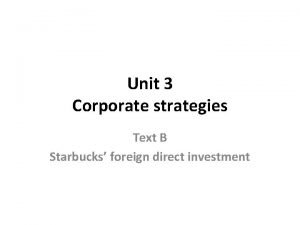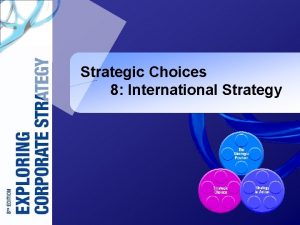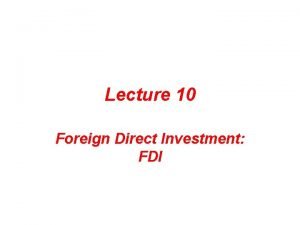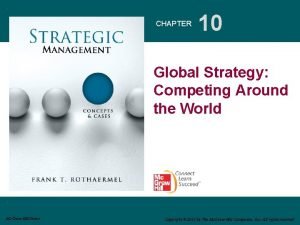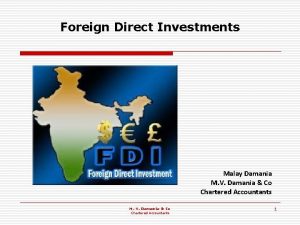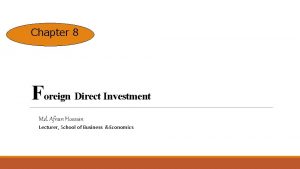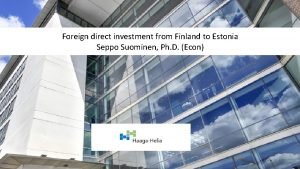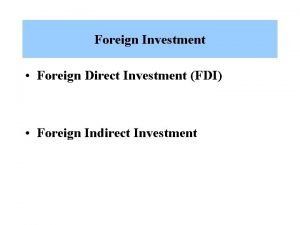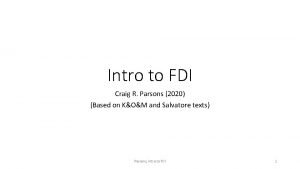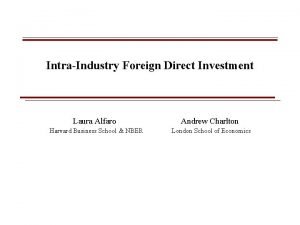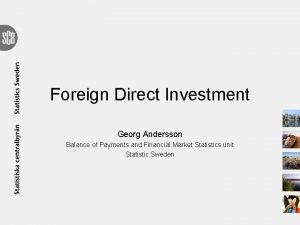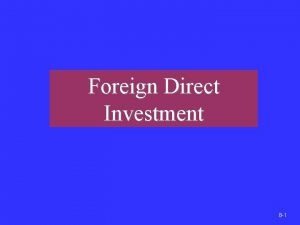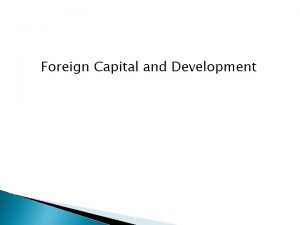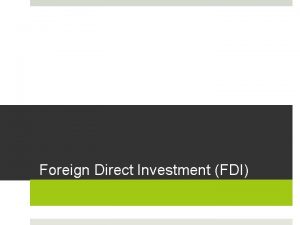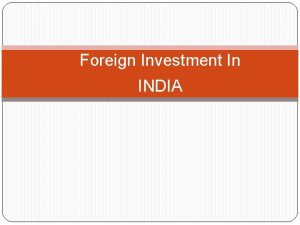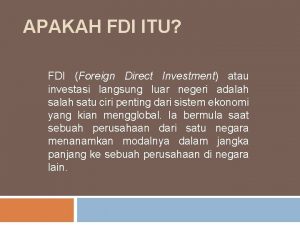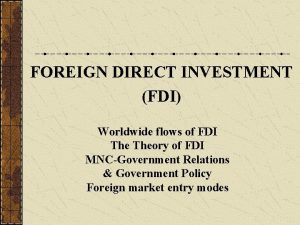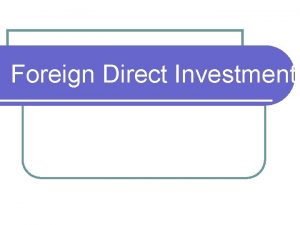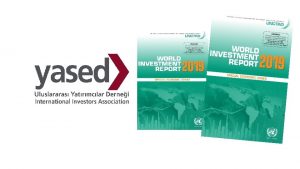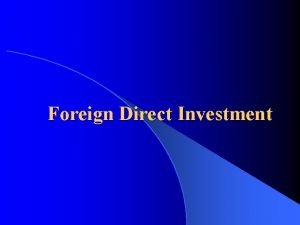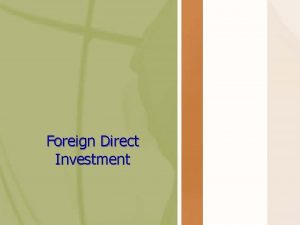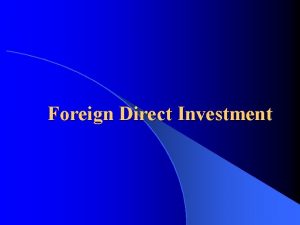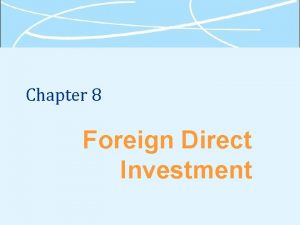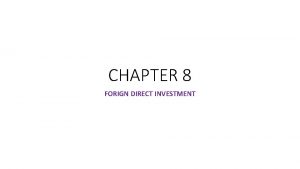Lecture 10 Foreign Direct Investment FDI Important Information


















- Slides: 18

Lecture 10 Foreign Direct Investment: FDI

Important Information • This Week’s Reading Assignments – Monday: Chapter 15: Foreign Direct Investment Theory and Strategy – Wednesday: Chapter 18: Cross Border Mergers, Acquisitions, and Valuations • Change in Project 4 and Quiz 4 dates – Project 4: change to Wednesday, Nov 12 – Quiz 4: Change to Wednesday, Nov 19

Entering a Foreign Market • Basic Entry Decisions: • There are four basic decision areas that a firm considering international activities needs to explore: • What is the purpose of the entry? – Production or selling? • Which markets to enter? • When to enter these markets? – Essentially the firm can be the first (or among the first) to enter. In doing so it may experience “first-mover” advantages. On the other hand, there are possible “Pioneering cost” disadvantages to being a first mover (e. g. , gathering knowledge about the market, educating consumers, and learning the rules of the game) • On what scale should the firm enter? – Firms generally tend to prefer relatively small commitments at first and then expansion later on if the market so warrants. Small-scale entry allows a firm to learn about the market while limiting its exposure. On the other hand, small-scale entry make it more difficult for a firm to build market share or capture first (or early) mover advantages.

Foreign Market Entry Modes • Once a firm decides to enter a foreign market, it then must make a decision about the mode of entry. Essentially, there are six basic modes a firm can select from: • Exporting (Importing) • Turnkey Projects – Turnkey projects involve the design, construction, and start-up of plants in foreign countries. Once the plant has been “started-up, ” it is turned over to local owner (client). Turnkey projects are common in chemical, pharmaceutical, petroleum refining, metal refining, and power plant industries. • Licensing – An arrangement whereby a licensor grants the rights to intangible property to another firm. Includes, patents, inventions, formulas, processes, designs, copyrights, and trademarks. • Franchising – Similar to licensing except that it tends to be longer term. Is typically used by service firms (e. g. , Mc. Donalds). • Joint Ventures • Wholly Owned Subsidiaries

Foreign Direct Investment (FDI) • Definition: The purchase of physical assets (e. g. , plant and equipment) in a foreign country to be managed by a parent company in another country. – Distinguish from portfolio investment! – Recall from Lecture 1 (slides 15 -17), FDI is the final stage in a firm becoming a multinational enterprise. – Form of FDI to consider: – Joint ventures or wholly owned subsidiaries? • Greenfield or acquisitions?

FDI Sequence Domestic Company and its Competitive Advantage Change Competitive Advantage Greater Foreign Presence Exploit Existing Competitive Advantage Abroad Production at Home: Exporting Production Abroad Licensing Management Contract Greater Foreign Investment Joint Venture Greenfield Investment Control Assets Abroad (FDI) Wholly-Owned Subsidiary Acquisition of a Foreign Enterprise

Market Imperfections: A Rationale for the MNE and FDI • MNEs seek to take advantage of imperfections across national markets or opportunities in overseas markets (that are not being met by competition). They can pursue their objectives through an FDI strategy: – Market seekers – produce in foreign markets to satisfy local demand – Raw material seekers – search for cheaper or more raw materials outside their own domestic market – Production efficiency seekers – produce in countries where one or more of the factors of production are cheaper (labor) – Knowledge seekers – gain access to new technologies or managerial expertise – Political safety seekers – establish operations in countries considered unlikely to expropriate or interfere with private enterprise

FDI Sequence Domestic Company and its Competitive Advantage Change Competitive Advantage Greater Foreign Presence Exploit Existing Competitive Advantage Abroad Production at Home: Exporting Production Abroad Licensing Management Contract Greater Foreign Investment Joint Venture Greenfield Investment Control Assets Abroad (FDI) Wholly-Owned Subsidiary Acquisition of a Foreign Enterprise

Joint Venture Definition • Definition: A combination of two or more companies into a single business organization. – Each party contributes to the organization (money, technology, plant, labor) – Each party owns a portion of the organization (equal stakes or majority/minority stakes) – Each party shares risk of failure

Reasons for Joint Ventures • Possible Reasons for Joint Venturing: – Government legislation requires it • India and Malaysia – Partners needs for each others’ skills • Managerial, production, distribution, understanding of the country – Partners needs for each others’ assets • Technology, products, capital, plant, labor – Large capital outlays may render wholly owned subsidiary unfeasible.

Joint Venture Example: Nike Japan • Nike Corporation: Headquartered in Oregon; designer and marketer of athletic footwear. – Founded in 1962 (as Blue Ribbon Sports) – 1963 Imported 200 pairs of athletic shoes from Onitsuka Tiger Company in Japan (International Trade stage) – 1971: The Swoosk trademark is created. – 1971: Name changed to Nike (Greek Goddess of Victory) – 1981: Nike Japan is created through a joint venture between Nike and Japanese trading company, Nissho Iwai (DFI stage)

Pros and Cons of Joint Ventures • Advantages – Combining with another firm and building on both firm’s comparative advantages. – Limits capital outlay. – Permits potentially better relations with local government, banks, labor unions, community! – Minimizes cultural risk. – Minimizes expropriation risk. • Disadvantages – Corporate disagreements • Corporate culture clashes (Anglo-American versus non-Anglo. American views regarding corporate objectives) – Sharing of profits

Wholly Owned Subsidiary – Definition: under a wholly owned subsidiary, a firm (parent company) operates a business overseas and retains 100% ownership. • It does not share the organization with another firm. • It contributes all the assets. • It assumes all the risk.

Pros and Cons of Wholly Owned • Advantages – One company running the entire business avoids potential decision-making conflicts and control issues. – No sharing of profits. • Disadvantages – High cost – Full risk exposure (if business loses money) – Possibility of not understanding local market.

History of American FDI • In 1851, Colt Fire Arms was the first American company to establish a manufacturing plant in England. The first “successful” American company into foreign production was Singer Sewing Machine. In 1867, Singer set up a manufacturing factory in Glasgow, Scotland by 1880 the company had become a worldwide organization with several overseas manufacturing plants and a worldwide foreign sales organization. Other U. S. firms followed Singer’s international lead. By 1914, 37 American companies had production facilities in 2 or more foreign locations: • • – – – Westinghouse, 1879, Paris, France (brakes) Eastman Kodak, 1889, London, UK (film) Ford Motor Company, 1904, Ontario, Canada

History of American FDI • Although U. S. companies have been involved internationally since before the Civil War, it wasn’t until the 1970 s, that U. S. companies went abroad on a massive scale. • • • U. S. Foreign Direct Investment (U. S. $ Billions; amount outstanding) Date Amount 1929 $ 7. 7 1940 7. 3 1950 11. 8 1960 32. 2 1970 75. 5 1980 213. 5 1990 430. 5 1998 980. 5

FDI Sequence Domestic Company and its Competitive Advantage Change Competitive Advantage Greater Foreign Presence Exploit Existing Competitive Advantage Abroad Production at Home: Exporting Production Abroad Licensing Management Contract Greater Foreign Investment Joint Venture Greenfield Investment Control Assets Abroad (FDI) Wholly-Owned Subsidiary Acquisition of a Foreign Enterprise

Greenfield Versus Acquisition • Greenfield investment versus acquisition – A greenfield investment is establishing a facility “starting from the ground up” • Usually require extended periods of physical construction and organizational development – Honda building an automobile assemble plant in Marysville Ohio in 1982! – A cross-border acquisition may be better because the physical assets already exist, shorter time frame and financing exposure • Ford buying Jaguar for $2. 8 billion in 1990! • However, potential problems with integration, paying too much for acquisition, post-merger management, and realization of synergies all exist
 Starbucks foreign direct investment case study
Starbucks foreign direct investment case study Foreign direct investment advantages and disadvantages
Foreign direct investment advantages and disadvantages Greenfield investment
Greenfield investment Foreign direct investment advantages and disadvantages
Foreign direct investment advantages and disadvantages Foreign direct investment in malay
Foreign direct investment in malay Afnan hossain
Afnan hossain So here you are too foreign for home
So here you are too foreign for home Foreign investment in finland
Foreign investment in finland Eclectic theory
Eclectic theory Fixed investment and inventory investment
Fixed investment and inventory investment 01:640:244 lecture notes - lecture 15: plat, idah, farad
01:640:244 lecture notes - lecture 15: plat, idah, farad Deciduous teeth dental formula
Deciduous teeth dental formula Vertical fdi examples
Vertical fdi examples Tratado kellog alfaro
Tratado kellog alfaro Fdi meaning
Fdi meaning Fdi meaning
Fdi meaning Fdi meaning
Fdi meaning Advantage and disadvantages of fdi
Advantage and disadvantages of fdi Fdi
Fdi
